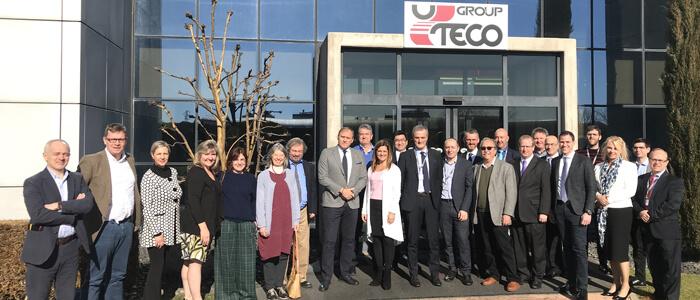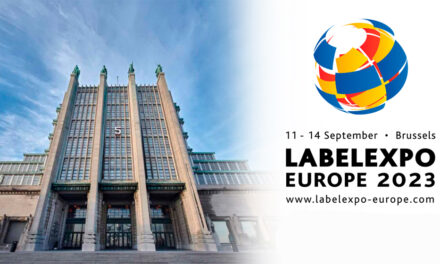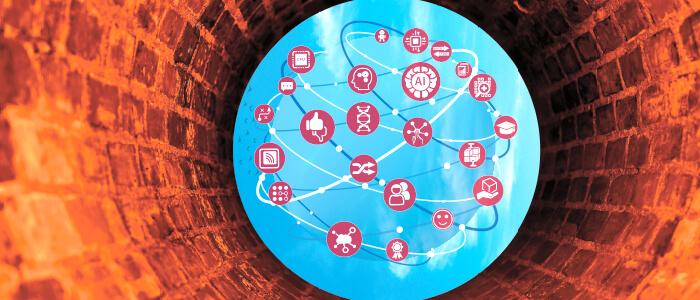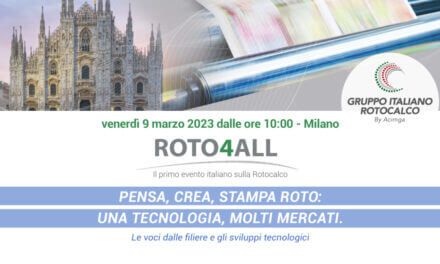The new Prosper Plus heads for continuous digital inkjet printing and the latest frontiers of Ultrastream technology in terms of speed, quality and economy. Kodak revs up its engines ahead of the upcoming drupa and demonstrates on the Sapphire EVO of its Uteco partner, in a summit that brought together technologists, analysts and specialized journalists from all over the world.
Appointment with international influencers at Uteco. Organized by Kodak on 6 and 7 February at the plant of the Italian partner (Uteco was the first to adopt the Kodak digital inkjet on its hybrid Sapphire EVO), the event was designated to explain to the technical press the determining role of the printhead in digital printing and the prerogatives of Ultrastream technology in achieving extraordinary results in terms of speed (the Sapphire EVO runs at 300 m/min on paper and 150 on plastic film) with superior quality and a very extensive gamut with only four colors, using water-based inks. For the occasion, the latest generation printheads under the Prosper Plus brand were presented, as well as the new frontiers of the Ultrastream (1200 dpi resolution, albeit at “only” 150 m/min: 3 times higher than its principal competitor) that will be officially launched at the next drupa 2020. Kodak makes it clear that the recent sale of the flexo business to the Montague investment fund – a 390 million dollar transaction which has greatly benefited R&D – does not mean leaving the graphic arts market, where it aims high, above all at packaging and labeling but not only there. And where, despite the delay accumulated compared to other major players, it competes for a place in the sun focusing on digital, were it holds all the cards of an advanced technology and performances that are game changers not only in terms of speed but also in terms of quality and of economy.
The Colognola-based event
Entitled Enterprise Inkjet Systems (EIS) Packaging Summit and VIP Media Analyst featured detailed information on Kodak systems and its users, as well as market stories and trends and the views of competent analysts. The top management of the American corporation were involved along with two users who have focused on Kodak digital and recounted its prerogatives and uses (Domenico Raccioppoli of Nuova Erreplast, first purchaser of Uteco Sapphire EVO and Ed Zumbiel of the eponymous American paper manufacturer, user of the Kodak system Prosper 6000S), as well as some of the leading international digital printing experts: John Snow from Ahead of the curve, who from the speakers’ rostrum gave a stimulating account on the impact of digital on brands and consumers and, in the audience, animating the debate with questions and observations, David Zwang, consultant and contributor of WhatTheyThink, and Sean Smyth, Smithers Pira print consultant.
The Prosper Plus new features
Patti Smith, Vice President of Worldwide Business Development & Marketing, explained the Enterprise Inkjet Systems Division in full: in Kodak, technology is developed to offer the market (converters and printers, as well as designers and brands) complete, totally economical and flexible solutions that use the widest variety of substrates and allow them to work without limitations of creativity.
[su_box title=”Sapphire Evo flies to Japan” box_color=”#e6000a” radius=”5″]
It’s official. Another Sapphire Evo has been purchased by Kinyosha, a reputed Japanese flexible packaging converter, with a strong orientation to the “short supply chain” (mainly serving the local market) and consequently also for short runs. The hybrid-digital printing machine developed in Uteco Converting in collaboration with Kodak reaches a quota of 2 a few months after the official presentation at the last Print4All, after the previous installations at the Italian Nuova Erreplast (CE). And a third contract is being finalized with destination USA.
[/su_box]
Kodak Prosper Plus Imprinting for packaging is based on a new generation of heads but also includes food inks and a water-based varnish for indirect food contact, free of VOCs, mineral oils and any non-reactive UV components, for the treatment of flat cardboard cartons and film for food, paper cups and plates as well as reams. The system can be integrated into Kodak branded machines, such as the one used by Zumbiel Digital, or independent OEMs like Uteco’s Sapphyre EVO hybrid. But the heads can also be marketed in their own right, to be mounted, for example, on Uteco’s installed flexo machine yard, an enticing target for the American corporate, but also featuring offset and gravure.
The new heads are available in 4 models – two for narrow formats and two for large formats – able to reach speeds up to 260 and 600 m/min. The former are able to reproduce barcodes, QR codes, promotional information on competitions, etc., in one color or four-color process; the latter are ideal for applications on corrugated and folding cardboard, labels and packaging.
Prosper Plus adopt a technology characterized by smaller ink droplets and higher resolution, which accelerate drying and improve print quality. Kodak is working with a number of leading partners in their respective fields of activity, to further extend their application possibilities. With Michelman, for example, to test the compatibility of Kodak inks and technologies on various substrates, such as PET, nylon and PP; with large suppliers of adhesives, primers, inkjet inks …; and of course with the OEMs to stimulate partnerships with the global manufacturers on the winning model of the one with Uteco (a specific function was created by Dan Denofsky), whose Sapphire EVO adopts all the components of the Kodak system, maximizing the advantages of Stream Inkjet of the American partner.
The evolution of the Ultrastream and the goals of Uteco
Kodak’s continuous digital inkjet technology, now in its fourth generation, documents superior performance compared to drop-demand and thermal alternatives, and attributes the same to a sum of many unique and “different” elements. In their speeches Dan Denofsky and Douglas Bugner talked about silicone nozzles that incorporate the state of the art of microelectromechanics (MEMS) and semiconductors (CMOS); plates hosting 2560 nozzles with a diameter of about 9 microns on 600 dpi files; heads that adopt an original ink drop recirculation system based on electromagnetism; constant pressure and flow of droplets with uniform and small diameter, low energy consumption, able to print with the utmost precision every type of section and graphic element; water-based and food-compliant inks, based on nanopigments that expand the color gamut with an exceptional yield even in four-color (the aforementioned 1200 dpi at a speed of over 150 m/min), even on the most challenging substrates …. and many other physical and chemical elements that explain the advantages of this system.
Uteco adopted it first, presenting Sapphire EVO in June last year, at Print4All, and attracting the attention of the global market. And is now relaunching, making Ultrastream the core of its high productivity digital development program for flexible packaging. «Our customers – said Aldo Peretti, CEO of Uteco Group – look for hybrid and sustainable digital production solutions to print short runs in a profitable way. These solutions, which combine traditional flexo and rotogravure printing technologies and digital inkjet printing technologies, optimize film processing, priming, precoating and drying to meet the demands of the packaging market. And Kodak’s patented continuous inkjet system ensures exceptional quality, productivity and operating costs. ”
But the digital horizon is no longer limited to short runs: «We have calculated – estimates Marco Cacciatore, project manager at Uteco – that up to 20,000 square meters, digital inkjet is cheaper, even economically speaking; after this threshold it is better to resort to flexography».
With the new frontiers of the Ultrastream, due primarily to even smaller ink drops, to the order of 4 picolitres, with an impact on the substratum of a few nanometers, the print quality rises further. Also on laminates, for which Kodak has formulated ad hoc products, able to meet the expectations of the industry in terms of welding strength, using solventless and solvent-based adhesives commonly used by packaging converters.
[su_box title=”Uteco: the satisfied testimonial” box_color=”#e6000a” radius=”5″]
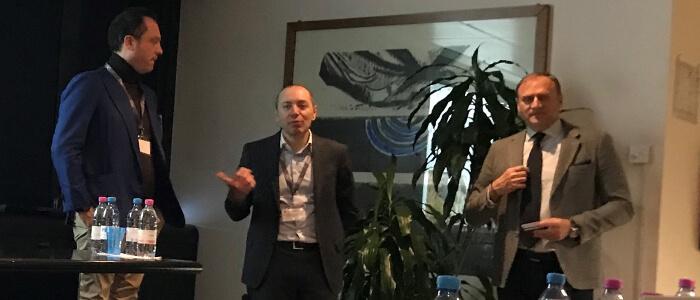
Domenico Raccioppoli, CEO of Nuova Erreplast, is a reserved person, but has willingly accepted, before the international audience of experts, to bear witness to his satisfaction with the successful outcome following the purchase of the first Sapphire EVO in the world. Even with the limitations due to the fact that the machine, for now, is working at the manufacturer’s (the transfer from Colognola to Marcianise will take place in the coming months), it fully prints a variety of jobs that the Campania based converter was not capable of carrying out beforehand.
«Nuova Erreplast has grown in the last ten years from 3.5 to 27.5 million of turnover, above all thanks to the great investments in technology. Now, with the entry into the company of the Uteco digital machine, and with the construction of a new factory of 56 thousand square meters, to be able to keep up the rhythms “imposed” by the commercial successes, we have laid the foundations for further development. In fact, for us, digital is not an alternative to flexo but the technology we lacked to be able to meet the needs of customization and to test new products on the shelf. Not to mention the economic advantages that can be obtained by adding the savings due to the lack of clichés to the higher margins ensured by jobs like these.»
The machine supplied by Uteco to Nuova Erreplast integrates a flexo unit for the printing of solid backgrounds and an element for coating, which enables the attainment of the soft touch effect so appreciated by the market.
«Our Sapphire EVO is not like the others but has been modified to our needs. It’s one of a kind», in fact underlines Raccioppoli. Aldo Peretti, CEO and President of Uteco, echoes him: «Customisation is what we are all about. All our machines are adapted to work as each converter requires». But the perhaps less obvious advantage of this investment concerns the relationship with large customers: «This machine and the innumerable projects that it is able to realize have attracted the attention of the big retail multinationals, that have come to see it and to test their jobs. In this way, in a very short time, we have started relations with potential customers who are much bigger than us, hungry for technologies that allow them to create new ideas and new products at the heady speeds of today’s change. New features and speed: these are today’s keywords of success».
[/su_box]

